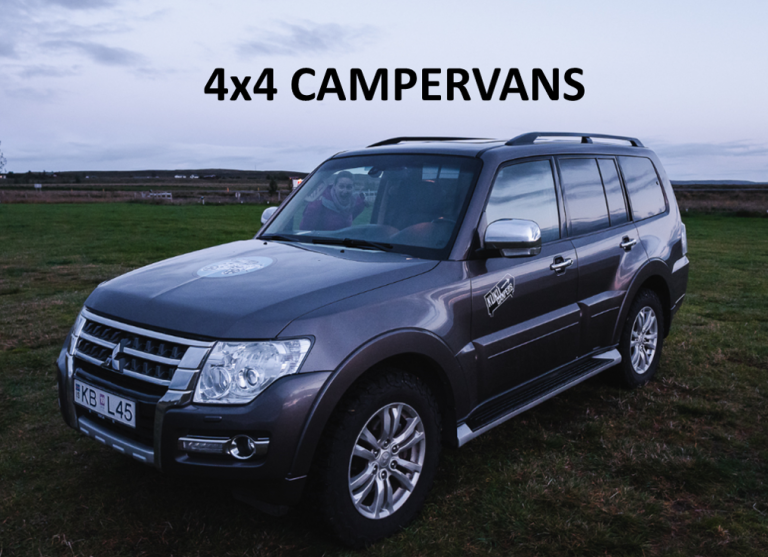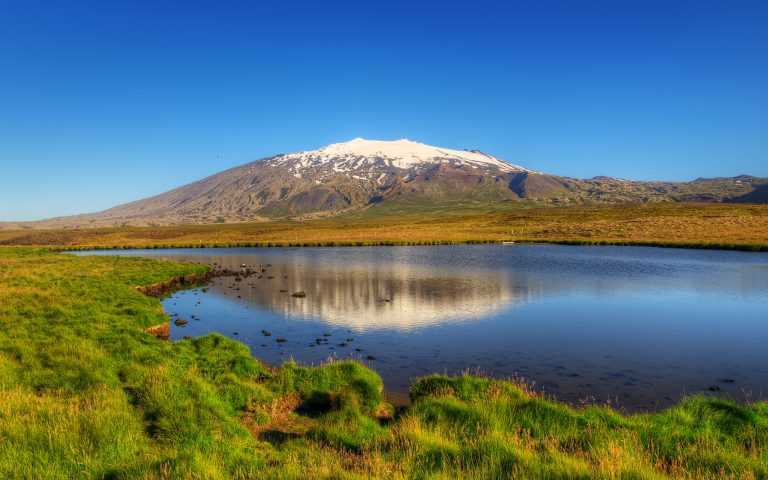
Iceland’s awe-inspiring geological features are a gift to science
Iceland is one of the most active volcanic regions on Earth, where almost all types of volcanic and geothermal activity can be found. The volcanism on Iceland is attributed to the combination of the Iceland plume hotspot activity and the Mid-Atlantic Ridge activity. The Mid-Atlantic Ridge is visible on land.
Iceland’s landscapes forged by the processes of volcanism include rift valleys, geysers, hot springs, rhyolite mountains, columnar basalt formations, lava fields and lunar-like craters. Subglacial volcanism has created table mountains in northern and southern Iceland.
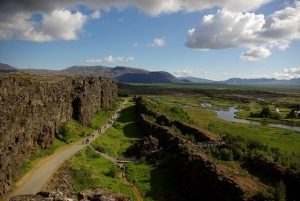
The Iceland hotspot and mighty geological phenomena
Iceland sits spanning the Mid-Atlantic Ridge tectonic plate boundary which separates the Eurasian and the North American plates. The ridge, an underwater mountain chain, extends about 16,000 km along the north-south axis of the Atlantic Ocean. A rift valley running along its spine is formed by plate tectonics and it’s the locus of new crust formation. Molten lava from beneath the Earth´s crust constantly wells up, cools, and is pushed away from the ridge´s flanks, widening the gap between the continents in the process.
Iceland formed by the coincidence of the spreading boundary of the North American and Eurasian plates and a hotspot or mantle plume – an upsurge of abnormally hot rock in the Earth´s mantle. As the plates moved apart, excessive eruptions of lava constructed volcanoes and filled rift valleys. Subsequent movement rifted these later lava fields, causing long, linear valleys bounded by parallel faults. The divergence of the ridge started in the north about 150 million years ago and 90 million years ago in the south. These movements continue today, accompanied by earthquakes, reactivation of old volcanoes, and creation of new ones. Iceland is the largest island on the ridge because of the additional volcanism caused by the hotspot under the country, the Iceland plume, which is moving slowly across towards the northwest. Other islands of the Atlantic Ocean created by the volcanism of the Mid Atlantic Ridge are The Azores, Bermuda, Madeira, The Canary Islands, Ascension, St Helena and Tristan da Cunha.
Volcanism in Iceland
Because Iceland lies on the Mid-Atlantic Ridge, it is being split by the movements of the shifting tectonic plates. The plates are moving apart, one to the east, the other to the west, and both the North American and the Eurasian systems are moving to the northwest across the hotspot. On top of hotspots there is generally a 20-100% molten layer at the depth of 5-20 km, which supplies sufficient material for eruptions. Iceland is home to more than 100 volcanoes, around 35 of which have erupted in recent history. The volcanism on Iceland is attributed to the combination of Mid-Atlantic Ridge activity and hotspot activity. Eruptions occur about every 5-10 years and primarily consist of basaltic lava and tephra. A few long-lived centres, such as the volcano Hekla, erupt more silicic magmas. The hotspot causes eruptions within the southern volcanic zone including volcanic systems such as Mt Hekla, Vestmannaeyjar (the Westman Islands), Katla caldera, Eyjafjallajökull (Eyjafjallajokull), the Laki area and the western subglacial part of the Vatnajökull (Vatnajokull) area where Grímsvötn (Grimsvotn) volcano is the most active.
Some of the most active areas of new crust formation are in the south-western parts of Iceland, accessible to tourists. The trip from Keflavík (Keflavik) airport to Reykjavík (Reykjavik) takes you along the edge of the North American plate where it meets the Eurasian plate. A drive to nearby Þingvellir (Thingvellir) valley, the site of the world’s first parliament, reveals an older part of the rift system, where you can see both sides of the plates´ boundary in one sweeping panorama. A flight to the island of Heimaey gives you a glimpse of the new land forming and of the hazards of living in the path of a spreading rift.
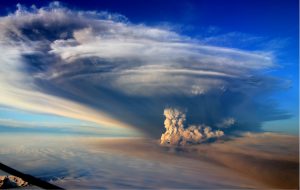
Landforms
Iceland can be divided into three zones based on the age of the basaltic rocks. Tertiary flood basalts make up most of the northwest quadrant of the island. This stack of lava flows is at least 3,000 m thick. Quaternary flood basalts and hyaloclastites are exposed in the central, southwest and east parts of the island. The Quaternary rocks are cut by the neovolcanic zone, areas of active rifting that contain most of the active volcanoes. The rifts are topographic depressions bordered by and containing many faults. Fissure swarms make up most of the neovolcanic zone. The swarms are 5-10 km wide and 30-100 km long. The rift zones have opened about 30 m in the last 3,000-5,000 years. The neovolcanic zone is about one-third of the area of Iceland. Almost 60% of the world’s regional fissure eruptions have been in Iceland.
Volcanic eruptions
Iceland is one of the most active volcanic regions on Earth. It is estimated that 1/3 of the lava erupted since 1500 AD was produced in Iceland. Iceland has 35 volcanoes that have erupted in the last 10,000 years. Eleven volcanoes erupted between 1900 and 1998: Krafla, Askja, Grimsvotn, Loki – Fögrufjöll (Fogrufjoll), Bárðarbunga (Bardarbunga), Kverkfjöll (Kverkfjoll), Esjufjöll (Esjufjoll), Hekla, Katla, Surtsey, and Heimaey. Most of the eruptions were from fissures or shield volcanoes and involve the effusion of basaltic lava.
Iceland was buried under ice in the last Ice Age and all eruptions were subglacial. Fragments of the ice caps remain and Iceland continues to have numerous subglacial eruptions. Of the world’s known subglacial eruptions, 83% are in Iceland. The eruption at Grimsvotn is an example. Subglacial eruptions produce a special type of volcano, called a table mountain or a moberg mountain. Great volumes of meltwater, generated by subglacial eruptions, can burst out from beneath glaciers to produce enormous glacial floods called jokulhlaup. The discharge can be as much as 20 times greater than the flow rate of the Amazon River.
The 1783 eruption at Laki was the largest single historic eruption of basaltic lava (14.7 cubic km). Recent eruptions include the 1974-1984 eruption at Krafla, a brief eruption at Hekla in 1991 and again on February 26, 2000, the Eyjafjallajökull eruption in 2010 and four eruptions at Grimsvotn: in 1996, 1998, 2004 and 2011.
Iceland is a place where a mid-ocean ridge can be seen on land
What’s more, Iceland is probably the only place in the world where the effects of two major tectonic plates drifting apart can easily be observed above sea level.
As well as its astounding beauty, the dramatic landscape at Þingvellir (Thingvellir) offers a chance to sight, on land and in shallow waters, the tectonic processes occurring along the submarine parts of a divergent ridge; processes that have been at play for millions of years.
What is a tectonic plate?
From a bird´s eye perspective, the Earth´s inner structure can be seen as consisting of several layers: the crust, the solid upper mantle, the viscous lower mantle, the liquid outer core and the solid inner core. The crust and the upper mantle together form the lithosphere (on average, 100 km thick); which is broken up into seven major and many minor “plates”, named tectonic plates. The lithosphere consists of continental crust and oceanic crust that surfaces in the ocean basins.
Simply termed, a tectonic plate, often also referred to as lithospheric plate, is a massive slab of solid rock that floats separately from the other tectonic plates, interacting with them along the boundaries. The continents are embedded in the tectonic plates and drift inertly along. The reason that tectonic plates are able to move, despite their colossal weight, is that the two types of crust, continental and oceanic, differ significantly in composition. The continental crust is predominantly made up of granitic rocks, whilst the oceanic crust consists of higher density basaltic rocks (therefore heavier), enabling the tectonic plates to float, not unlike icebergs.
It is the interactions along the tectonic plate boundaries, where they converge, diverge, or slip past one another, that are thought to be the main cause of most of Earth´s seismic and volcanic activity. The scientific theory of plate tectonics (formulated in the 1960s), which incorporates the concepts of continental drift and seafloor spreading, describes these large scale tectonic movements.
Tectonic plates in Iceland
The tectonic plates whose turbulent interactions formed Iceland, are the Eurasian tectonic plate and the North American tectonic plate. Spanning the Mid-Atlantic Ridge, Iceland emerged as a result of the divergent, spreading, boundary between these two plates and the activity of Iceland´s own hotspot or mantle plume. As the plates moved apart, excessive eruptions of lava constructed volcanoes and filled rift valleys. Subsequent movement rifted these later lava fields, causing long, linear valleys bounded by parallel faults. The divergence of the ridge started in the north about 150 million years ago and 90 million years ago in the south. These movements continue today, accompanied by earthquakes, reactivation of old volcanoes, and creation of new ones. Iceland is the largest island on the ridge because of the additional volcanism caused by the hot spot beneath the country, which moves slowly towards the northwest.
The tectonic plates move towards east and west, and both the North American and Eurasian systems move to the northwest across the hot spot. On top of hot spots there’s generally a 20-100% molten layer at the depth of 5-20 km, which supplies sufficient material for eruptions. Eruptions occur about every 5-10 years and primarily consist of basaltic lava and tephra. A few long-lived centres, such as the volcano Hekla, erupt more silicic magmas.
Iceland’s topography
Based on the age of the basaltic rocks, Iceland can be divided into three zones. Tertiary flood basalts make up most of the northwest quadrant of the island. This stack of lava flows is at least 3,000 m thick. Quaternary flood basalts and hyaloclastites are exposed in the central, southwest and east parts of the island. The Quaternary rocks are cut by the neovolcanic zone, areas of active rifting that contain most of the active volcanoes. The rifts are topographic depression bordered by and containing many faults.. Fissure swarms make up most of the neovolcanic zone. The swarms are 5-10 km wide and 30-100 km long. The rift zones have opened about 30 m in the last 3, 000 to 5, 000 years.
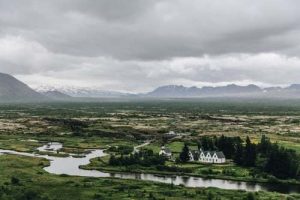
Natural phenomena at Þingvellir-Thingvellir
The uniqueness of Iceland in geological terms is nicely expressed in the words of Our Amazing Planet writer: “On a recent sunny afternoon in Iceland, a group of scientists took in a view of geological grandeur that nearly everywhere else on Earth would require a deep diving submersible. They were standing in Thingvellir, a sweeping valley surrounded by majestic cliffs …” The writer also mentions “some legendary sight-seeing”.
Being at Thingvellir, one is always struck by awe, in the literal sense of the word; intensely aware of being in the presence of the primordial forces that continue to shape Iceland, and our planet, and at the same time profoundly touched by the solemn, stately, deceptively tranquil beauty of the surroundings. It’s an unforgettable experience.
When visiting Iceland, the trip from Keflavík (Keflavik) airport to Reykjavík (Reykjavík) takes you along the edge of the North American plate where it meets the Eurasian plate. A drive to nearby Thingvellir valley, which is also the site of the world’s first parliament, reveals an older part of the rift system, where you can see both sides of the plates’ boundary in one breath-taking panorama. A voyage or flight to the island of Heimaey gives you a glimpse of new land forming and of the hazards of living in the path of a propagating rift.
Iceland is a bird watcher’s paradise, and among the world’s 10 best countries for whale watching
Iceland is surrounded by the cool clear North Atlantic Ocean, but the Gulf Stream sends a steady supply of warm water up past Iceland making it warmer than would be expected in a land at this latitude. Iceland’s coastal waters play a key role in making the country so rich in birds and marine mammals.
The only land mammal living in Iceland before the settlers came was the Arctic fox. It’s believed that the Arctic fox travelled across the frozen sea in the very distant past and found a home here.
The abundance and accessibility of birdlife in Iceland makes Iceland a birder’s paradise
The fact that Iceland lies in the North Atlantic just under the Arctic Circle, between Europe and the American continent, as well as its vicinity to Greenland, has implications for the diversity of bird species in Iceland. Due to its geographical position, Iceland is famous for the occurrence of vagrants, and its location in the North Atlantic makes it an excellent place to look for rarely seen birds coming from both North America and Europe.
Two other characteristic elements also play a big role with regard to bird life in Iceland. Firstly, the Iceland lowlands have exceptionally mild winters given their northern latitude. This leads to hosting very unlikely winter visitors, such as the common European Grey Heron from Norway. Secondly, there are hardly any (real) trees in Iceland and summers are cool. These are unfavourable elements for many passerines. However, Iceland has a long coastline, providing both breeders of low coastal regions and cliff breeding birds with ample space for breeding.
The most sought after species by birders and birdwatchers visiting Iceland are the Icelandic Gyrfalcon, the largest falcon in the world, the Red-necked Phalarope and the Puffin. All can easily be found with some experience or local guiding. Bird watching in Iceland is a richly rewarding experience for everyone who enjoys nature.
Bird species seen in Iceland
Although Iceland is Europe´s second largest island it has only 75 breeding species. Most breeding species are very numerous, though, and are easily seen everywhere around Iceland. For example, the most numerous bird in Iceland is the Atlantic Puffin, there being some three to four million pairs. In a colony just outside Reykjavik there are more than 20,000 pairs. The Icelandic bird list isn´t very long, but over 350 bird species have been recorded in Iceland, an amazing total considering the small number of breeding species.
Common on the cliffs of Iceland are the auks, species belonging to the same Alcidae family of seabirds as the puffins. The steep perpendicular cliffs are used mostly by the common guillemots (Uria aalge) and the closely related Brünnich’s guillemot (Uria lomvia) which is a more northern close relative of the common guillemot. On higher parts of the cliffs the Razorbill (Alca torda) is more common. The popular Atlantic Puffins (Fratercula arctica) breed in self dug hollows on the edge of the rocks and grass turfs. Since they stay close to the edge and near their burrows, tourists can approach them easily. The Black Guillemot (Cepphus grylle), is also common in Iceland, especially in the Breiðafjörður (Breidafjordur) area. It breeds in rock hollows of lower coast lines.
Other birds are also typical for the cliffs. These are the kittiwakes (Rissa tridactylla) and the fulmar (Fulmarus glacialis). Kittywakes breed only on cliffs at the sea shore while fulmars can also be found much further inland and also on high mountain slopes along the coast. Fulmars resemble gulls but are in fact member of the Petrel family. Shags (Phalocrocorax aristotelis) and Northern Gannets (Morus bassanus) are also cliff breeding birds. Shags are more common in the western region (Snaefellsnes and Breidafjordur) while gannets frequent the south-western coasts of Iceland. Iceland’s national bird, the Gyrfalcon (Falco rusticolus) habitually nests on cliff faces. This magnificent bird breeds in all parts of Iceland but is commonest in the north. The Falcon is most noticeable in autumn and is a great favourite with bird watchers.
Bird watching locations in Iceland
There are many places where one can visit these cliffs. Well known are the Vestmannaeyjar (Westman Islands), Arnarstapi on the Snaefellsnes peninsula, the Breidafjordur area. The Breidafjordur is also famous for the sea eagle, also known as the White-tailed Eagle (Haliaeetus albicilla). By far the most famous place to visit cliff breeding birds is the Látrabjarg (Latrabjarg) Cliffs, located on the westernmost tip of the Vestfirðir (Westfjords) district. Other places of interest are the Grímsey (Grimsey) Island on the Arctic Circle north of mainland Iceland and, in the south, Ingólfshöfði (Ingolfshofdi) Cape and Dyrholaey. A special feature is Lake Mývatn (Myvatn) in northern Iceland where an exceptional number of duck species and other waterfowl breed.
The sheer abundance and accessibility of birdlife in Iceland makes it an ideal destination for birding and bird watching. A detailed description, specifying the types of birds you can see in and around Iceland through different seasons is provided on our Bird Watching page.
You will all have a tale to tell from your visit to Latrabjarg Cliffs. It’s a great place to see and photograph seabirds as the Arctic sun bounces on the horizon at midnight. Latrabjarg is as far west in Europe as any man will stand on solid ground, the continent’s westernmost boundary. It’s one of the three largest bird cliffs in Iceland, the other two being Hornbjarg and Hælavíkurbjarg (Haelavikurbjarg) in the Hornstrandir Nature Reserve. Latrabjarg is by far the easiest of the three to visit as a road leads practically to the cliffs’ edge and from the parking lot a walking path traverses the edge. In summer it is a popular tourist destination and the main attraction is the Puffin. In few places in Iceland, if any, are the puffins more trusting towards humans. For a few months every year, this massive 440 metre high and 14 kilometre long cliff becomes alive with the nesting activity of millions of seabirds. The seabird colonies at Latrabjarg are enormous, and they include the world’s largest known Razorbill colony at Stórurð (Storurd), ‘The Giant Boulders’, scree beneath the cliff. The puffins seen by their burrows at the cliff’s edge are not the most numerous species, but they are arguably the most noticeable. Other auks that breed at Latrabjarg are Razorbills, Common Guillemot and the Brünnich Guillemot, a high Arctic species that is at its southern breeding limit in Iceland, and one of the target birds for any serious birder and birdwatcher visiting the country.
The Icelandic Society for the Protection of Birds has taken part in establishing and running a nature reserve in the Southern Lowlands of Iceland, the Flói Nature Reserve. This is a wetland area rich in birdlife, Wildfowl and Waders being the most common birds in the reserve. The most common wader is the Dunlin, over 80 pairs/km. This is the highest breeding density ever to be reported for this species in Iceland.
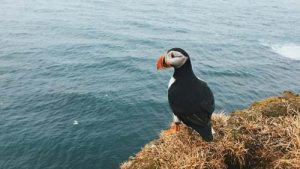
Iceland is home to one of the world’s largest colonies of puffins
Over half of the world´s population of the Atlantic Puffin breeds in Iceland, somewhere between 3 – 4 million pairs each year. The total population of puffins in Iceland is estimated to be between 8 and 10 million birds. The Atlantic Puffin is one of the four species of puffins and the one most commonly found in Iceland. Icelandic word for puffin is “lundi”.
Puffins on Latrabjarg, Hornbjarg, Hornstrandir, Haelavikurbjarg, Breidafjord and Lundey
There are a number of places in Iceland where you can see the Atlantic Puffin. Látrabjarg Cliffs (Latrabjarg) in the Vestfirðir (Westfjords), the westernmost point in Europe, is one of the three largest bird cliffs in Iceland. The other two large bird cliffs are Hornbjarg and the Nature Reserve Park of Hornstrandir, both in the north-west of Iceland. Hornstrandir is an ideal place to combine hiking and bird watching. Other puffin areas are the Vestmannaeyjar, (Westman Islands), Breiðafjörður (Breidafjord) and Lundey – Puffin Island, just 3 minutes’ sailing from Reykjavik, which has a puffin colony of around 20 000 birds.
The puffins in Hornbjarg and Hælavíkurbjarg (Haelavikurbjarg) are more trusting towards people than in other places, due to the fact that these areas do not harvest puffins. No puffins or birds are caught in Hornstrandir Natural Reserve Park. We humans are only visitors in their backyard. Many puffins in that area are so tame that we can sometimes crawl slowly towards them and even gently touch them, without scaring them away.
Puffins have also started making their homes on the second newest island on our planet, Surtsey, which erupted from the ocean off the south coast of Iceland as a volcano in November 1963. However, only scientists are allowed to land on Surtsey, to be able to observe the ecological processes unfold, undisturbed by human interference.
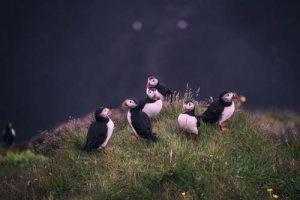
Puffins on the Westman Islands
On the Westman Islands, which hold about half of all Icelandic puffins, the puffins are both harvested and rescued. Puffins have been a vital source of food through the centuries for Icelanders in the islands. However, they are harvested sustainably. Icelanders also rescue puffins when in August millions of new-born puffins leave their burrows in the cliffs of Heimaey – the main island in the Westman Islands. Puffins leave at night using the moon to navigate, but the streetlights of Heimaey seem to throw some of the young birds off their flight paths. When that happens, it’s time for the children of Heimaey to launch the Puffin Patrol – a search and rescue operation for the befuddled birds, which, instead of flying out to sea, fly into town where they crash-land in the streets. The children of Heimaey have been rescuing young puffling chicks (“pysja” in Icelandic) for generations. In fact, at the end of summer, releasing the puffins by their hundreds to the safety of the sea has become a local tradition.
The South Iceland Natural History Institute has done extensive research into the puffins’ habitats and migratory behaviour. Air photographing and counting of the puffins’ nesting burrows has enabled ornithologists to assess that the Westman Islands habitat contains 1/5 of the world´s total number of puffins, confirming that the Westman Islands in Iceland are the largest single puffin colony in the world.
Puffin characteristics
Puffins spend most of their lives on the water, coming ashore only to breed and raise their single puffling (chick) each year. Along with the other alcids (auks), puffins swim well underwater using their flapping wings to propel them under the surface and their webbed feet to manoeuvre. Their bodies, similar in shape to the flightless penguins, are wonderful for diving and swimming but clumsy in the air. Puffins can dive to depths of about 60 metres. Taking off from land, a puffin may jump from a cliff to get enough lift to fly. From the water, a puffin flaps furiously into the wind to get airborne, similar to how airplanes head into the wind during take-off. Though hardly graceful, they are surprisingly swift flyers, able to reach a speed of 88 km an hour by flapping their wings 400 times per minute.
There are many fabulous pictures of puffins with their bills full of dangling fish; often all neatly lined up. How can a puffin hold one fish while catching another? The answer lies in the fact that they use their tongues to hold the fish securely against spines in the roof of their mouths, while leaving their beaks free to open and catch more fish. Because of their specially adapted beak, a hungry puffin’s mouth is capable of holding up to 60 fish (albeit small ones) at a time.
Puffin: “little brother of the north”
The Atlantic Puffin is the species most commonly seen in Iceland. Puffins belong to the Alcidae (auks) family of seabirds. The other puffins in the auk family are Horned Puffin, Tufted Puffin and the Rhinoceros Auklet. Puffins are beautiful and fun to look at. They exhibit amusing antics and manoeuvres both in air and on land. Perhaps it is this combination of strange colourful look and quirky behaviour that makes them so loveable.
The Latin name for Atlantic Puffin is Fratercula arctica – “little brother of the north”. The name Fratercula – “little brother”, or “friar” – may have come about because of their habit of holding their feet together when out of water, giving the appearance of praying. It could also have been an allusion to their black and white plumage resembling a cleric’s clothing. On the other hand, their multi-coloured beak has prompted people to give them nicknames such as “the sea parrot” and “clown of the sea”.
Features
No doubt the Puffin is one of the top photo models in bird photography. The colourful heavy beak and the white face is so characteristic that it cannot be confused with any other species. Note that it has red legs and feet like the black guillemots but unlike all other auks of the region. A characteristic feature of the puffins, contrary to other auks, is their “at rest” position. They usually stand upright on their feet. Other auks usually sit on their lower legs. Also, the puffin can walk much better than other auks.
Puffins talk in their underground burrows. In Iceland, they nest in the soft earth in underground tunnels, so the sound one hears them make in their cosy earthen rooms is a muffled growling-moaning. If you sit quietly on the grass, you’ll hear them talking underground in their nests.
Breeding
During breeding season, an adult puffin’s beak turns a bright orange and yellow colour. Atlantic puffins also have blue on their bills. Their feathers form a rosette at the base of the bill. As winter draws near, the adult will shed the sheath on his bill, exposing a smaller dark bill. The feathers around their eyes moult and are replaced with darker ones. With these seasonal changes, the puffins’ appearance changes dramatically. In fact, it was once thought that the puffins with their winter colouring were a different species from the well-known puffins in their breeding plumage.
During the winter, puffins often live a solitary life or in small groups, never setting foot on the ground but living totally at sea. But during spring, as the warm breezes blow, they begin their journey back to their nesting ground, the same one where they were born. Arriving at the shore, they may spend a few days still in the water; congregating with others and possibly locating their mate whom they may not have seen since the previous year. Finally, the puffins decide it’s time to become land animals once more. They find their nesting place from the year before, meeting their mate there if they’d not had a water rendezvous a few days earlier. Puffins usually keep the same mate for life. However, if no offspring are produced for several years, they will “divorce” and find a new mate. Puffins breed when they become five years old. If a puffin is at the age to begin breeding, it will seek out a mate from the other young puffins or take an older mate whose previous partner had died.
Like other auks, puffins breed in colonies. One egg is laid generally in burrows on the boundary of rock and turf layers but also in other protected spots. Atlantic puffins dig burrows underground, about 2 feet in length for their nest, using their beaks to dig and their webbed feet to kick the dirt out. The same puffin was found nesting in the same burrow for 30 years, which means it was at least 35 years old.
Ringing Puffins
The South Iceland Natural History Institute has colour-ringed and electronically tagged puffins in the Westman Islands, for research purposes, in order to gain insight into their habits and migratory behaviour. The lighthouse keeper at Stórhöfði (Storhofdi) in Westman Islands, Óscar J.Sigurðsson, has alone labelled about 85, 000 birds, mostly puffins – a world record in bird labelling. Ringing, air photographing and counting nesting burrows of puffins has enabled ornithologists to assess that Westman Islands habitat contains 1/5 of the world´s total number of pufifins, confirming that Westman Islands in Iceland are the largest single puffin colony in the world.
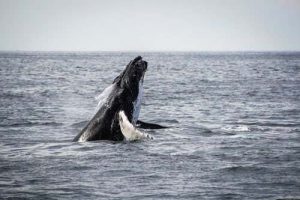
Enjoy whale watching from harbours all around Iceland’s coast
Many species of whales can be seen in the waters around Iceland. The cool, clear North Atlantic Ocean encircling Iceland is rich with food for whales of various sizes and species. Most common are minke whales and white-beaked dolphins, but killer whales are also frequently seen. The most famous killer whale of all times, Keiko, perhaps better known as Willy, was born and caught in Icelandic waters.
Currently, 23 species of cetaceans are being spotted in Iceland. If you are lucky, you can see the huge humpback whales, waving their flukes and sometimes leaping, a sight that will amaze you. Humpback whale flukes are large, notched in the centre, and the whales nearly always show them when leaving the surface. Sperm whales are rarely spotted and pilot whales only at times. Porpoises frequently leap near the whale watching boats and follow them playfully around.
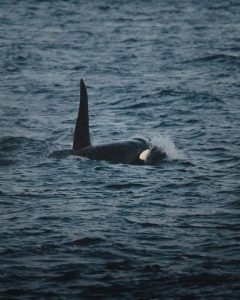
Whale watching around Iceland
In the north of Iceland, the main whale watching port is Húsavík (Husavik); in the Midwest are Ólafsvík (Olafsvik) on the Snæfellsnes (Snaefellsnes) peninsula and Höfn (Hofn) in the southeast of Iceland. The ports on the Reykjanes Peninsula are Keflavík (Keflavik), Sandgerði (Sandgerdi) and Grindavík (Grindavik) which are only a 40-45 minute drive from the capital Reykjavík (Reykjavik) and only 5 minutes from Keflavik International Airport. Whale watching is also available from the capital area, both from Reykjavík and Hafnarfjörður (Hafnarfjordur) harbour.
Whale watching is probably the single most popular activity for tourists in Iceland during the summer time and it´s growing, although it is still far from being too commercial. The spotting locations are not swarming with other crafts full of tourists. Small groups are taken out. There are usually no other vessels except those of the local fishermen and, apart from sighting the majestic whales, the tour operators usually try to show their guests a variety of sea birds, such as the Atlantic Puffin and sometimes you can see some seals.
One of the most amazing mammals in the world, whales can boast of being the biggest animal ever, the mammal with the longest migration, the deepest-diving mammal and one that is capable of emitting the loudest noise in nature. In the world, there are about 90 different kinds of cetaceans: whales, dolphins and porpoises that have been recognised and registered as a special breed. About 10 new species of cetaceans have been discovered in the last 10 years.
Icelandic waters cover areas of the cold Arctic Ocean in the north, to the warmer North Atlantic Ocean in the south. Various ocean currents are constantly bringing food and creating conditions for good food areas where the currents meet. The long sun period during the summer provides good conditions for krill and other crustaceans, the basic food of the oceans.
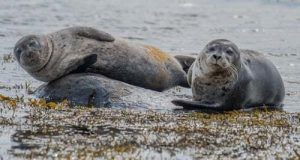
Seals
Iceland´s vast and uninhabited coast still offers many inaccessible areas which provide sanctuary for the two species of seals that give birth to their pups in Iceland. The harbour seal is more common than the grey seal, with numbers in the tens of thousands. All the other seal species frequenting the Arctic can be found along the shore from time to time, even though visits from some are considered a rarity.

